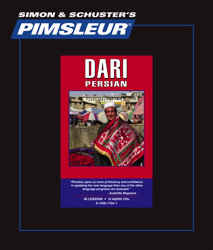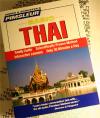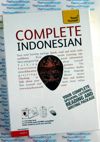Pimsleur Comprehensive Dari (Persian) Level 1 - Discount - Audio 16 CD

Pimsleur Comprehensive Dari (Persian) Level 1
Get other Dari Language audio click here
Upon completion of this Level I program, you will have functional spoken proficiency with the most-frequently-used vocabulary and grammatical structures. You will be able to:
* initiate and maintain face-to-face conversations,
* deal with every day situations -- ask for information, directions, and give basic information about yourself and family,
* communicate basic information on informal topics and participate in casual conversations,
* avoid basic cultural errors and handle minimum courtesy and travel requirements,
* satisfy personal needs and limited social demands,
* establish rapport with strangers in foreign countries,
* begin reading and sounding out items with native-like pronunciation.
About the Afghan Language Dari
Dari (Persian: دری) is the official name for the Persian language spoken in Afghanistan and is a synonymous term for Parsi.
Origin of the word "Dari"
There are different opinions about the origin of the word Dari. The majority of scholars believe that Dari refers to the Persian word darbār, meaning "Court", as it was the formal language of the Sassanids. This opinion is supported by medieval sources and early Islamic historians.
Geographical distribution
In Afghanistan Dari is also called Farsi or Parsi. These different names have been used synonymously to refer to the spoken language.
Iranian languages are widely used language in Central Asia both by native speakers and as trade languages. Many of these languages are frequently mutually intelligible.
Dari is a branch of the Indo-Iranian (Indo-Aryan) languages, a subfamily of the Indo-European languages. There are three different phases in the development of Indo-Iranian languages: Old, Middle, and Modern.[citation needed] Old Dari/Farsi and the Avestan language represents the old stage of development and were spoken in ancient Bactria. The Avestan language is called Avestan because the sacred scriptures of Zoroastrianism, Avesta, were written in this old form. Avestan died out long before the advent of Islam and except for scriptural use not much has remained of it. Old Dari, however, survived and there are many written records of old Dari, in cuneiform called Maikhi, in Khorasan.[citation needed] Old Dari was spoken until around the third century BC. It was a highly inflected language.
Dari is the major language of Afghanistan, and is spoken in the northern and western parts, and the capital, Kabul, in the east. Approximately 70% of the population of Afghanistan are native speakers.
Also, due to large emigration from Afghanistan, there are thousands of Dari speakers around the world, notably in North America, Australia and many European countries. There are small minority groups of Dari speakers in Pakistan (mainly in NWFP).
Grammar
The syntax of Dari does not differ greatly from Iran's Persian. The stress accent in Dari is different, but just as prominent as those in Iran's Persian. To mark attribution, spoken Dari uses the object marker -ra. The vowel system also differs from that of Iranian Persian, to some degree.
In addition, the major grammatical difference is the usage of continuous tense. In Iran's Persian, the verb “to have” (Persian: dāshtan) is used before any other verb to indicate a continuous action. While in Dari, the expression "dar hālé" (at the moment of), is used with the simple present or past tense to express a continuous state. Nevertheless, some Dari speakers in Afghanistan have recently adopted the structure used by Iranians.
History
Dari was the official language of the Sassanids' court. It emerged as the language of the Persians after the defeat of the Parthians by Ardeshir I in 226 CE. Dari is also referred to Middle Persian, or to a classic style of Persian language. The term "middle" Persian suggests the existence of an Old Persian and a New Persian. Old Persian was the language of the Achaemenids, which was overshadowed by Greek after the conquests of Alexander the Great.
The Muslim conquests broke the continued chain of the Persian language and Arabic (for two hundred years, i.e. 7–8 century CE) became the official language. The Persians, however, did not forget their own language and little by little, Middle Persian was being shaped into New Persian (or Dari) was influenced by Arabic loanwords and was written in the Arabic script. New Persian (or Dari) became the main language of people of Transoxiana and Khorasan in 9th century, and later, it became widespread in other parts of Iran, as well as non-Iranian regions such as India, and Anatolia . Therefore, Transoxiana and Khorasan are regarded by many as the birthplace of Persian language and Persian literature.
The Old, Middle, and New Persian are and represent the same language at three stages of its history. The New Persian language is what is called today as Farsi or Dari. "Farsi" is the local name of the Persian of Iran and "Dari" is the local name of the Persian spoken in Afghanistan. The New Persian remains close to the Middle Persian in many respects. However, New Persian has taken many words from Arabic, as opposed to Middle Persian which was influenced, to a lesser degree, by Aramaic. The grammatical structure has also undergone minor changes, mainly in relations to verbal morphology and syntax.


 0 Items (Empty)
0 Items (Empty)






 (Custom).png)
